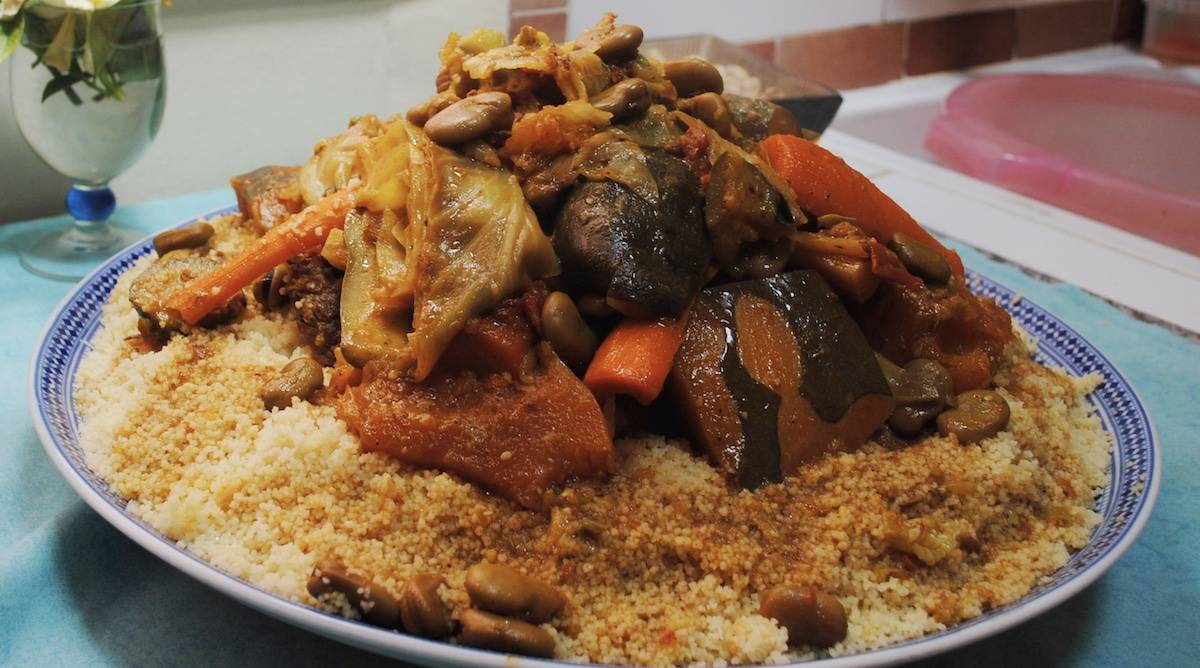Couscous, a staple in North African cuisine, has gained popularity worldwide due to its versatility and ease of preparation. But for those unfamiliar with this grain-like food, a common question arises: What does couscous taste like?
Well, to give you a straight answer, the taste depends on which couscous you’re eating. The couscous you’re looking for is always accompanied by meat/chicken, vegetables, raisins, caramelized onions…
The taste will depend heavily on what you’ve chosen or cooked. But all in all, it’s really delicious. Especially if you’re really a fan of the mixed flavors.
Quick Summary
- Couscous is a type of dried tiny pasta made from wheat flour and semolina.
- It comes in various varieties, including Moroccan and Lebanese.
- The sidekicks decide the taste.
- The flavor is mild and neutral, with a slightly nutty undertone.
- Couscous is rich in nutrients, especially protein.
The Origin and Types of Couscous
Couscous originates from North Africa and is a staple in countries like Morocco, Algeria, and Tunisia. It’s made by moistening wheat flour and semolina, then tossing them until tiny balls form. There are three common types:
- Moroccan Couscous: The smallest variety, often available as instant-cook.
- Lebanese Couscous (Moghrabieh): Resembles chickpeas in size and can be found in dried or fresh versions.
Taste and Texture Explained
Couscous has a mild, neutral taste, slightly nutty due to its wheat flour and semolina composition. Its texture varies: smaller types like Moroccan couscous are tender, while larger varieties like jews couscous are chewier. Though it resembles quinoa, they are distinct, with couscous being a type of pasta and quinoa a whole grain.
Versatility in Dishes
One of couscous’s strengths is its adaptability. Its mild flavor allows it to be paired with a myriad of ingredients without overpowering them. Whether as a side dish, in salads, or as the main course, couscous can be a delightful addition to various recipes.
It blends well with the other ingredients. its deliciousness combined with other delicious preferences make it a favorite dish for many.
Even the build and presentation of the dish is really cool.
Nutritional Benefits
Beyond its taste, couscous offers nutritional benefits. A ¼ cup of dry couscous provides:
- 5.52g protein
- 33.49g carbohydrates
- 163 calories
- 0.28g fat
- 2.2g dietary fiber
While it’s not gluten-free, it’s a healthy option for vegans and vegetarians due to its protein content.
Cooking Tips
Couscous is easy to prepare. For instant Moroccan couscous, it takes about 10 minutes. For larger varieties, simmering in water is the method. It can also be cooked similarly to rice, seasoned for added flavor, and best served hot or at room temperature to avoid clumping.
Although the traditional way is to steam it before adding chicken or meat broth along with veggies, raisins, onions…
International dish
Couscous, while rooted in North African traditions, has found its way into kitchens worldwide. Its adaptability has made it a favorite among chefs and home cooks alike, who appreciate its ability to absorb flavors and meld seamlessly into various cuisines.
Pairing Couscous with Proteins
The neutral profile of couscous makes it an ideal companion for a range of proteins. Whether it’s the robust flavors of grilled lamb, the delicate notes of pan-seared fish, or the earthiness of lentils and beans for vegetarians, couscous provides a balanced backdrop.
Vegetables and Couscous: A Harmonious Blend
From the vibrant colors of bell peppers to the deep greens of spinach and kale, vegetables add not just visual appeal but also a burst of nutrition and flavor. Roasted, sautéed, or raw, they elevate the couscous dish to a wholesome meal.
Herbs and Spices: The Flavor Enhancers
Couscous, when paired with herbs like mint, parsley, or cilantro, takes on a refreshing note. Spices like cumin, coriander, and turmeric infuse it with warmth and depth, making each bite a flavor-packed experience.
Sauces and Couscous
Whether it’s a tangy tomato-based sauce, a creamy yogurt drizzle, or a spicy harissa paste, sauces can transform the simple couscous into a gourmet delight. The grains absorb the sauce, becoming little pockets of flavor.
The Health Aspect: Is Couscous Good for You?
While couscous is rich in protein and fiber, it’s essential to balance it with other food groups for a well-rounded meal. Pairing it with vegetables, lean proteins, and healthy fats ensures you get a spectrum of nutrients.
Couscous in Desserts: An Unexpected Delight
While not as common, couscous has made its way into the dessert realm. When sweetened and paired with fruits, nuts, and a drizzle of honey or syrup, it becomes a delightful treat, offering a unique texture contrast.
Couscous Across Cultures
While couscous is quintessentially North African, its journey across continents has led to its integration into various cuisines. From the Mediterranean shores to the bustling streets of New York, couscous has been embraced and reinvented.
Couscous in Mediterranean Cuisine
The Mediterranean diet, renowned for its health benefits, has incorporated couscous as a staple. Paired with olive oil, fresh vegetables, and seafood, it captures the essence of the sun-soaked region.
Asian Fusion with Couscous
In Asia, where rice and noodles dominate, couscous has found its niche. Whether it’s a stir-fry with a twist or a base for a spicy curry, couscous adds a unique texture and flavor profile.
Modern Gourmet Dishes
Top chefs globally are experimenting with couscous, creating gourmet dishes that challenge traditional culinary boundaries. From couscous risottos to stuffed vegetables and inventive salads, the possibilities are endless.
The Sustainability Aspect
Sustainability wise, couscous stands out. Its production requires less water compared to other grains, making it an eco-friendly choice. Moreover, as a crop, it’s resilient to harsh conditions, ensuring food security in challenging climates.
Storing and Cooking Tips
To retain its freshness, couscous should be stored in a cool, dry place. When cooking, it’s essential to fluff it with a fork to prevent clumping. For those looking to enhance its flavor, cooking in broth or adding a dash of olive oil can make a significant difference.
The Nutritional Breakdown of Couscous
Diving deeper into the health benefits of couscous, it’s essential to understand its nutritional profile. Rich in vitamins and minerals, it’s a powerhouse of energy.
- Carbohydrates: As a primary source of energy, the carbs in couscous fuel the body, keeping you active and alert.
- Protein: Essential for muscle repair and growth, couscous provides a decent amount of protein, especially when paired with legumes or meat.
- Fiber: Beneficial for digestion and heart health, the fiber in couscous aids in maintaining a healthy gut.
- Vitamins and Minerals: From selenium, which supports the immune system, to magnesium, vital for nerve function, couscous is a treasure trove of essential nutrients.
Couscous for Special Diets
For those on specific diets, couscous can be a valuable addition:
- Vegetarians and Vegans: As a protein source, it can be paired with beans, lentils, or tofu for a balanced meal.
- Gluten Sensitivity: While traditional couscous contains gluten, gluten-free varieties made from corn are available in the market.
Couscous in the Modern Kitchen
With the rise of quick meals and meal prepping, couscous has become a favorite. Its quick cooking time and adaptability make it perfect for busy lifestyles. From cold salads to warm main courses, it fits seamlessly into various meal plans.
Pairing Beverages with Couscous Dishes
The right drink can elevate a couscous dish:
- Buttermilk: Organic buttermilk is one of the fresh and traditional drinks that go along with couscous in North Africa; mainly Morocco.
- Teas: Herbal teas like mint or chamomile can be refreshing with a spicy couscous dish.
Couscous: Beyond the Traditional
While couscous has deep-rooted traditions, the modern culinary world has embraced it with open arms, leading to innovative dishes that push boundaries.
Breakfast with Couscous
Move over oatmeal; couscous is making its mark in the breakfast realm. Sweetened with honey, topped with fresh fruits, nuts, and a sprinkle of cinnamon, it becomes a wholesome morning treat.
Couscous in Snacks
Innovative chefs are turning couscous into snackable delights. Think couscous patties, crispy couscous balls, or even couscous-stuffed peppers.
Dessert Innovations
Couscous in desserts? Absolutely! When paired with chocolate, berries, or infused with flavors like rose or orange blossom, it transforms into a delightful dessert base.
The Global Influence Revisited
From the streets of Marrakech to the bistros of Paris and the cafes of New York, couscous has left its mark. Each region has added its twist, creating a tapestry of flavors and textures that celebrate this humble grain.
In Conclusion
Whether you’re trying it for the first time or a regular consumer, understanding its taste, varieties, and preparation methods can enhance your dining experience. But most of the times, Delicious or super delicious, is going to be your answer when asked: What does Couscous taste like?



